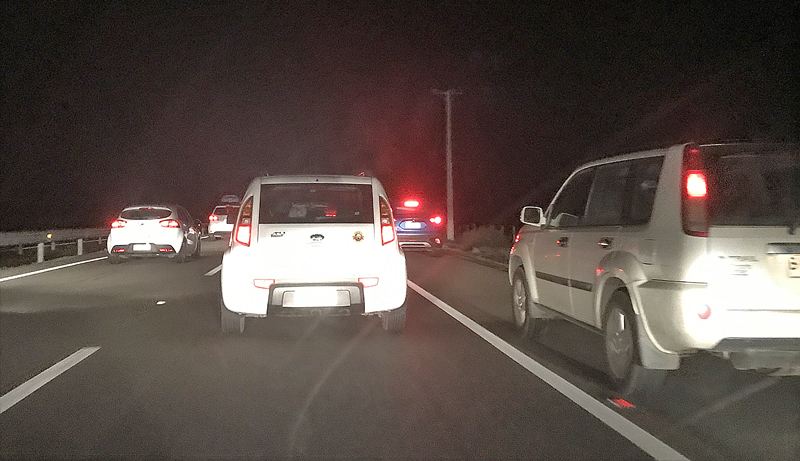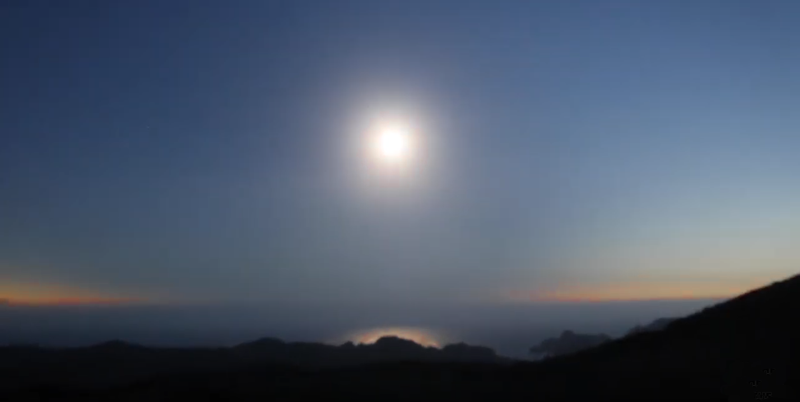I left the DoubleTree by Hilton Hotel Santiago – Vitacura before noon the day before the total solar eclipse was to occur so that I can drive the 428 kilometers — or 266 miles — north up to Tongoy, where I was going to one of the worst hotel properties at which I have ever stayed.
The Total Eclipse of the Sun Chile July 2019: A Poor Video of a Great Celestial Event
Unfortunately, the drive is expensive because of 14,150 Chilean pesos in tolls one way, which is approximately $20.56 in United States — or $41.12 round trip — which does not include the electronic tolls within Santiago. To avoid the tolls, the duration of the 4.5 hour trip would have doubled to almost nine hours — and as much as I prefer to avoid tolls, this option was simply not worth it to me…
…and not knowing what the traffic would be like in the unusual event of a total solar eclipse, that nine hour drive while avoiding tolls on narrow winding roads through local towns in the Andes mountain range could easily double — and that does not include the possible cost of extra fuel for that detour. Taking Ruta 5 — also known as Panamericana Norte — was realistically the only option; and I resigned myself to it.
After staying the night in Tongoy, I left the hotel property prior to 9:00 in the morning to drive the remaining 82 miles to the center of totality of the path of the solar eclipse.

After scoping the area in the bright sunshine under clear skies, I chose a site at approximately 11:30 in the morning which I believed to be optimum for viewing a total solar eclipse — it is actually south of the eclipse spot on the map shown below.
As the total solar eclipse was not scheduled to happen until just after 4:30 in the afternoon, I had five hours to wait in the middle of nowhere. Good thing that I had an ample amount of snacks and water in the car…
…but at approximately 1:00 in the afternoon, clouds started to form. By 2:00, the sky was completely overcast. My hope of seeing this total solar eclipse was fading fast.
…until I looked up into the sky: cumulous clouds were starting to form — and with every mile traveled, they multiplied and grew larger.
Great. Just great.
The sun was still out, though. The chances of seeing a total eclipse were plummeting as my car crept closer to the state line, which I did not believe I was going to reach in time…
…but then traffic started moving again; and at a good clip. Excellent. Ten more miles to the border. Nine. Eight…
…and then traffic slowed down significantly again. I have 45 minutes left until totality. I will cross the state line in time; so I will get to see totality — but I had almost 30 miles to go.
Once I drove across the border into South Carolina, the traffic resumed at highway speeds. The reason is because the rest area in South Carolina was crawling with humans like ants on a mound. People were everywhere — on the grass, in the road — pointing their fingers and cameras to the now mostly cloudy sky.
26 more miles in 40 minutes. Doable. I am going for it.
Plink. Plop. Splat.
That was when the rain started. Rain? Downpour became the more appropriate word under the now dark gray sky. Certainly not ideal weather for viewing an eclipse — let alone being outside at all.
I then reached my go or no go moment. Continue on to the location which I favored? Stop short of my goal? Turn around and head back? The weather was worsening while time was running out — and quickly.
What happened next seemed like a miracle — literally minutes before the total solar eclipse started:
…and incredibly, the clouds disappeared — for the most part, anyway — around the area of where the sun was shining…
There is still plenty of time, I thought to myself. Maybe these clouds will eventually disappear before the total solar eclipse starts.
My wish came true — and in plenty of time. Unfortunately, I did not bring a tripod with me due to the extra weight, so the video which I decided to shoot on an impromptu basis came out shaky.
My only regret is that I did not take a couple of photographs of the horizon during this total solar eclipse, as it turned a hue of orange — as if the sun was setting — as the sky darkened when the total solar eclipse started. The effect can be seen in the video. I did not see that phenomenon in South Carolina in 2017 because I had a hotel property, trees, clouds and rain in the distance obstructing my view of the horizon.
The Long, Long Drive Back to Santiago

Knowing that the drive back to Atlanta from South Carolina more than tripled in duration from what would have been a typical two hours, I did not know what the traffic would be like returning to Santiago, which without traffic would be a duration of almost six hours of driving 528 kilometers — or slightly greater than 328 miles.
Upon reaching La Serena, traffic was at a near standstill. I decided to stop off at the mall in La Serena to use the washroom — I had not been to one since I was in Tongoy earlier that morning, which meant that I went without a toilet for at least ten hours — and to pick up a few hamburgers with extra pickles at McDonald’s, for which I had to order in my broken Spanish because they did not understand English. I also figured that stopping for a quick bite for dinner would allow the traffic to dissipate somewhat — similar to my experience when I stopped off for dinner on my way back to Atlanta in 2017.
Nope.
After finally escaping La Serena — the normally limited access highway had traffic lights on this stretch, which did not help matters at all — I entered Coquimbo, which also has traffic lights.
As I am sitting in bumper-to-bumper traffic — barely moving when I can — I suddenly had a bus driver behind me, flashing his lights, honking his horn incessantly, and screaming a tirade in Spanish to me.
I immediately stopped the car from speeding at the mind-blowing rate of maybe a quarter of a kilometer an hour, which infuriated him even more, if that was possible.
As I was treated to his impromptu light show using his headlights — accompanied by the cacophony of monotone horn blasts accentuated with what was probably the worst profanity one could scream in Spanish, I wondered what he wanted me to do: drive into the trunk of the car in front of me and come out through its engine?
Thankfully, he exited at an off ramp not long after that — when he was able to reach it — and although it took a while, I finally passed the last traffic light in Coquimbo, at which traffic started to move at highway speeds again.
Not long after that, something told me to fill up the fuel tank of the car — even though the tank was three-quarters full. I spotted a fuel station where only a few cars were awaiting their turn to be refueled. The price was right, too: at 812 Chilean pesos per liter — or approximately five United States dollars to the gallon — that was one of the least expensive prices I have seen during my visit to that country.
The somewhat free flow of traffic did not last long, though: at every toll booth all the way to Los Vilos — which is approximately halfway between the path of totality and Santiago — was miles upon miles upon miles of traffic…
…and at every toll booth, drivers honked their horns wildly. My only guess is that they were protesting the toll booths causing the extensive traffic delays during what became nighttime.
Literally hundreds of cars lined the shoulder of the southbound lanes of the highway because their drivers decided to sleep there for the night — although I would not be surprised if some of the cars were out of fuel…
…and long lines — which stretched out into the highway — greeted those motorists who had little other choice than to stop at one of the several fuel stations all the way back to Santiago.
Thank goodness I had the foresight to top off the tank with gasoline. Despite using up fuel in traffic, I still had plenty of gasoline in the tank when I finally arrived back in Santiago.

Many impatient motorists took upon themselves to use the breakdown lane to bypass the heavy traffic — which was extremely dangerous given how many vehicles and people were stopped in that lane on the side of the highway for various reasons.
Even significantly worse than the toll booths was a traffic jam caused by construction on the highway and forced the merging of two lanes into one, as the movement of traffic was slowest at this point of the entire trip.
I did not arrive back at the DoubleTree by Hilton Hotel Santiago – Vitacura until 12 hours after the totality portion of the solar eclipse ended. I checked in at approximately 5:30 in the morning — to the astonishment of the lone woman manning the front desk — and did not go to sleep until after 6:00 in the morning.
I then slept a few hours, had breakfast, left for the airport, returned the rental car, and started on my long journey back to the United States. I did not arrive home until approximately 10:00 the next morning.
I suppose that the foresight of heading towards the path of totality the day before the total solar eclipse was a smart move. If the traffic heading towards it that day was anything like it was heading away from it that evening, I would have had to leave Santiago at 4:30 in the morning at the absolute latest in order to not have missed the total solar eclipse.
Summary
If you have the opportunity to see a total solar eclipse in person, do whatever you can to see it. Not everyone will be amazed by it; but I was — and your next opportunity is in southern Chile and southern Argentina on Monday, December 14, 2020.
At least one person asked me whether or not all that driving was worth seeing the total solar eclipse in person, I responded without hesitation: “Definitely YES!!!” I would do it all over again in a heartbeat — and did…
…but I do not plan on viewing another total solar eclipse again — especially after all of the time, effort and money spent in preparation for this event — although I might change my mind in 2024, when the next total eclipse of the sun is expected to occur in the United States on Monday, April 8, 2024. Included in the path of totality will be cities such as Dallas, Indianapolis, Cleveland, Buffalo, Rochester and Burlington.
Things which I have learned from my experience with a total solar eclipse include:
- Clouds could actually enhance the photographs of a solar eclipse during its partial phases — but not necessarily for a total solar eclipse
- Consider reserving a room at a nearby hotel property so that you do not have to deal with traffic — especially in an area within range for 9.6 million people which was my destination in 2017; or even 74.6 million people near Santee in South Carolina — but be prepared to pay top dollar in room rates
- Do not let inclement weather or traffic deter you from completing your mission, as you never know when — or if — good fortune will come your way, as it did for me
- You can use solar eclipse glasses to protect your camera while taking photographs by covering the lens — ensure that absolutely no direct sunlight can get through — but I would recommend getting a special filter to fit on your lens instead for better quality and focusing
- If you do not want to reserve a hotel room, leave yourself plenty of time for driving or however you intend to travel to the desired location
- A tripod may not be enough — consider using the delayed picture option to reduce blurriness from shaking the camera
- You can view the total eclipse of the sun without any aids — but once that “engagement ring” effect appears, that is the time to wear your special solar eclipse glasses once again
- Never stare at the sun — even with solar eclipse glasses — for long periods of time; and never look directly into the sun at any time whatsoever without any protection for your eyes
All photographs and video ©2019 by Brian Cohen.

